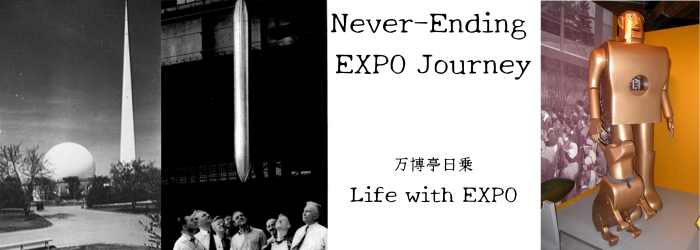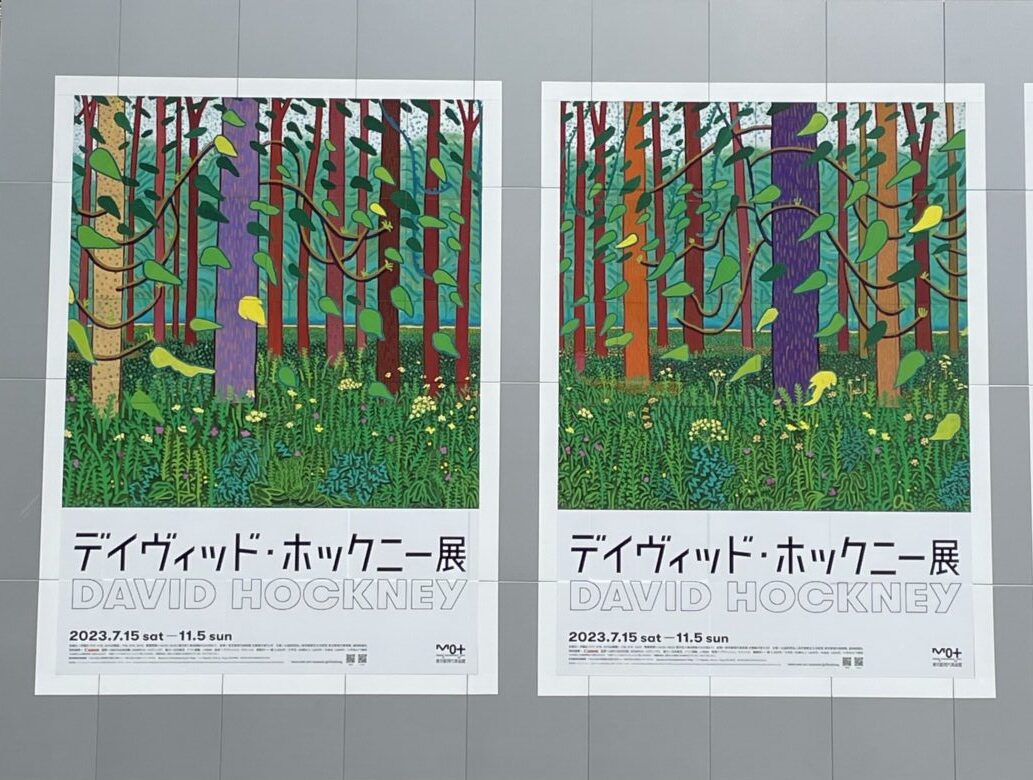To “David Hockney Exhibition”
It was July 22nd, not long after the Exhibition opened, that I headed to the David Hockney Exhibition being held at the Museum of Contemporary Art Tokyo.
At that time, the author and the assistant No. 0, who were around Shimbashi, decided to go to the “David Hockney Exhibition” that had been on our minds for some time.
Toei Bus bound for Tokyo Skytree Station
It is a line called “Nari 10” that departs from Shimbashi Station and goes to Tokyo Skytree station.
“Nari 10” used to be “bound for Narihirabashi”, so it must be a remnant of that.
Get on from the bus stop near Shimbashi Station, turn left, go right on the old Dentsu Dori, and turn right at the intersection of Harumi Dori, where only buses can turn right.
Tsukiji Hongwanji Temple and Ito Chuta
As soon as I got on the bus, I started doing my usual New York Times crossword puzzles, so I didn’t see much of the scenery, but after a while, I saw Tsukiji Hongwanji Temple on my left.
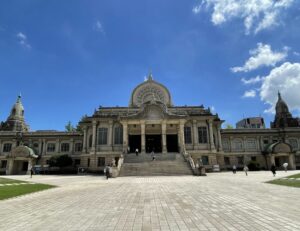
築地本願寺
Tsukiji Hongwanji Temple
Tsukiji Hongwanji Temple was designed by Ito Chuta (1867-1954).
Now, looking up his year of birth, we can see that it was 1867, the year of the 2nd Paris Universal Exposition.
Since his birth date is November 21st, it is known that when he was born, Eiichi Shibusawa (1840-1931) and Akitake Tokugawa (1853-1910) were still a staying in Europe, as they traveled to Paris as a representative of the Edo shogunate to participate in that Paris Universal Exposition.
Anyway, Ito Chuta is an architect who was active from the Meiji to the Showa eras.
He is also famous for designing the “Kanematsu Auditorium” of Hitotsubashi University (Tokyo University of Commerce), which Eiichi Shibusawa was involved in its founding.
In addition, he has worked on many famous buildings such as Kashihara Jingu, Heian Jingu, Miyazaki Jingu, which I often visited when I was a child, the main gate of the University of Tokyo, Okura Shukokan, and Yushima Seido.
The first Expo held in Japan was the Osaka Expo in 1970, but in fact, the Expo, which would later be called the “Phantom Expo,” was planned to be held in 1940 (Japanese Imperial Era 2600).
The plan was canceled due to the war, but preparations were progressing reasonably well.
I introduced this in detail in episodes 60 to 65 of my book “100 EXPO Stories 1851-2025“, so if you are interested, please refer to that.
Ito Chuta was one of the members of the “Venue Planning Committee” set up for this “Phantom Expo.”
The “Phantom Expo” and Kachidoki Bridge
While thinking about such things, when I returned to the crossword puzzle again, Assistant 0 told me,
“It seems that the Kachidoki Bridge is under construction now.”
It is a valuable “expo-related information.
Certainly, when viewed from the bus, the Kachidoki Bridge is covered with brownish boards.
When I looked it up later, it seems that this is called “Kachidoki Bridge Life Extension Construction”.
According to the “Chuo-ku Tourism Association Correspondent’s Blog“, it is as follows along with the photo.
*
Under the Kachidoki Bridge, construction is underway to connect the Sumida River Terrace. Construction is scheduled to be completed by February 2021.
On the Kachidoki Bridge, construction work is being carried out to extend the life of the bridge. Bridge painting work.
Construction period: December 12, 2022 to February 27, 2024
Construction site: From Tsukiji 6-chome to Kachidoki 1-chome
For details, please refer to the announcement of Tokyo Metropolitan Government.
*
Speaking of Kachidoki Bridge (construction started in June 1933, completed on June 14, 1940), it is a splendid (?) “expo-related thing” that was built as the “Main Gateway” of the “Phantom Expo” introduced earlier.
I don’t know if that was the reason (?) , but in 2007, it was designated as an “National Important Cultural Property”.
This is a “Chicago-type two-leaf bascule bridge”, and it is a “movable bridge” whose central part can be opened and closed to allow passage of large ships on the river.
However, the last time it opened was on November 29, 1970, when the Osaka Expo was held, and it is currently not open.
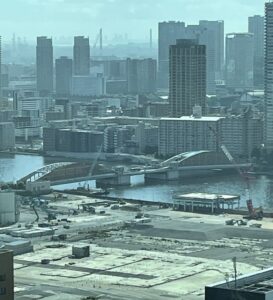
「長寿命化工事」中の「勝鬨橋」
手前は、築地市場跡地
“Kachidoki Bridge” under “life extension construction”
In the foreground is the ex-site of Tsukiji Market
This time’s construction is also “construction to extend the life”, so I hope they keep doing this kind of construction to leave it to future generations as a thing to commemorate the Expo forever.
By the way, I passed Kachidoki Bridge in no time.
To the Museum of Contemporary Art Tokyo
I went back to today’s crossword puzzle.
It used to be convenient to use Wi-Fi on the Toei Bus, but for some reason the service ended on November 30, 2021, so I didn’t surf the net, Just keep doing puzzles.
On the bus, turn left at the Toyosu intersection, turn right at the Edagawa intersection, turn left at Mitsume-dori, and after passing Eitai-dori while looking at the Ito-Yokado Kiba store on our left, we saw Kiba Park on our right.
But we shouldn’t rush down. After seeing Kiba Park, the fourth stop is finally the stop called “In front of the Museum of Contemporary Art Tokyo”.
Several people, mostly young people, got off at this stop.
It is hot today.
It’s too hot and I don’t want to wait for the traffic light, so I cross the pedestrian crossing while it happens to be green.
Luckily, it’s cool inside the museum.
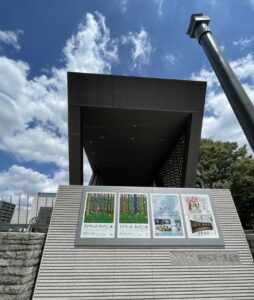
David Hockney Exhibition
David Hockney (1937-) is a British contemporary artist.
He is now 86 years old.
I’ve been a fan of Hockney’s work for a long time, and I used to hang his poster in the room I used to live in.
He was born in 1937, which means that was when, Picasso’s “Guernica” and Miró’s “The Harvester” were exhibited at the “Pavilion of the Republic of Spain”, and Picasso was also included in the “Masters of Independent Art Exhibition 1895-1937 “ held at that time, exhibiting his “Demoiselles d’Avignon”.
Matisse’s “Dream”, and “Odalisque with red culottes” were also exhibited in 1937, the year of the Paris Exposition.
It may not be because he was born in the year of the Paris Exposition of 1937, when Picasso exhibited two of his masterpieces, but perhaps there was some kind of fate (?), page 9 of the explanation of exhibition catalog says as follows:
*
Hockney, who saw Pablo Picasso‘s exhibition at the Tate Gallery in 1960, was strongly impacted by the artist’s sheer creativity supported by great command of style. (Bold letters are by the author. The same applies below.)
*
Certainly, there are many works that we feel the influence of Picasso’s Cubism.
The commentary on page 55 of the catalog reads as follows.
*
In the backdrop to this was Hockney’s encounter with the printer responsible for the production of Picasso’s final prints, shortly after the artist’s death in 1973. This opportunity to engage in an indirect dialogue with the artist he admired the most, had enabled Hockney to rediscover multiple perspectives in Cubism, leading to the production of his portfolio “The Blue Guitar,”made using new techniques he had learned from Picasso’s printer.
*
The works in this “Blue Guitar” are influenced not only by Picasso during the Cubist period, but also by periods before that. The composition of “The Old Guitarist” is almost the same as “The Old Guitarist”, a work of the same title drawn in Picasso’s “Blue Period”.
The “Blue Guitar” Frontispiece reads:
*
THE BLUE GUITAR
ETCHINGS
BY
DAVID HOCKNEY
WHO WAS INSPIRED
BY
WALLACE STEVENS
WHO WAS INSPIRED
BY
PABLO PICASSO
*
Wallace Stevens (1879-1955) was an American modernist poet who wrote the long poem “The Man with the Blue Guitar” (1936) inspired by Picasso’s “The Old Guitarist” (1903-04).
However, after that, Hockney’s style seems to have changed from Picasso’s style and opened up his own colorful and free world.
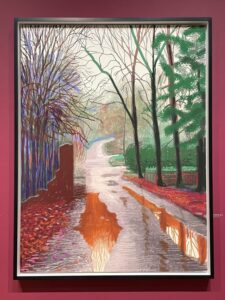
12月29日 No.2
29 December, No.2
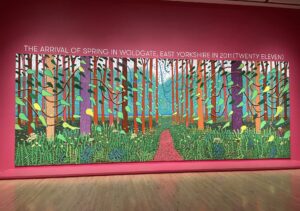
『春の到来 イースト・ヨークシャー、ウォルドゲート 2011年』
“The arrival of Spring in Wordgate, East Yorkshire in 2011 (twenty eleven)”
This exhibition also includes a large-scale 70-meter-long work called “A year in Normandie 2020-2021” which is said to have been influenced by Japanese (oriental) picture scrolls.
The explanation of the exhibition panel is as follows.
*
It was in this place, loved by many painters such as Gustave Courbet, Claude Monet, and Raoul Dufy, that he tried to delve deeper into the transient natural landscape through the production of ‘The Arrival of Spring.
*
Gustave Courbet, Claude Monet, and Raoul Dufy are all writers associated with the Expo.
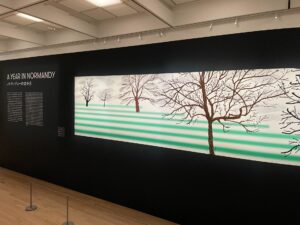
『ノルマンディーの12か月』
“A YEAR IN NORMANDY”
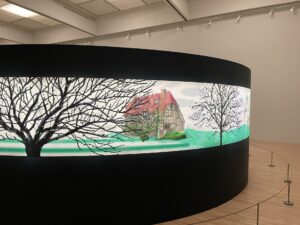
『ノルマンディーの12か月』
“A YEAR IN NORMANDY”
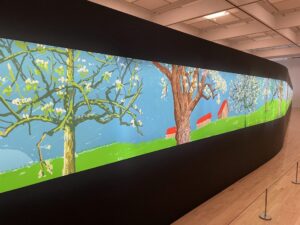
『ノルマンディーの12か月』
“A YEAR IN NORMANDY”
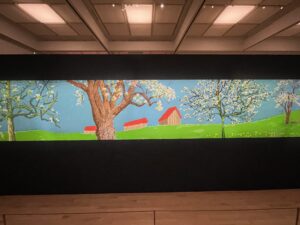
『ノルマンディーの12か月』
“A YEAR IN NORMANDY”
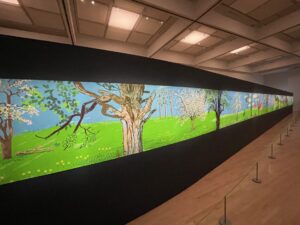
『ノルマンディーの12か月』
“A YEAR IN NORMANDY”
In addition, you can enjoy various works such as “Walking in Zen Garden at the Ryoanji Temple, February 1983, Kyoto” with Japanese motifs.
Also, many works created with iPads are exhibited in a way that allows you to understand the production process.
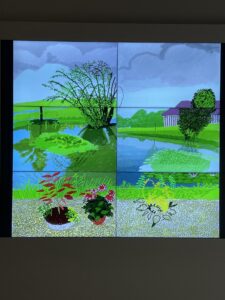
『2021年6月10日-22日、池の睡蓮と鉢植えの花』
“10th -22nd June 2021, Water Lilies in the Pond with Pots of Flowers”
This is also a new form of Hockney art.
It will be held until November 5, 2023, so I recommend that you take a look at it.
